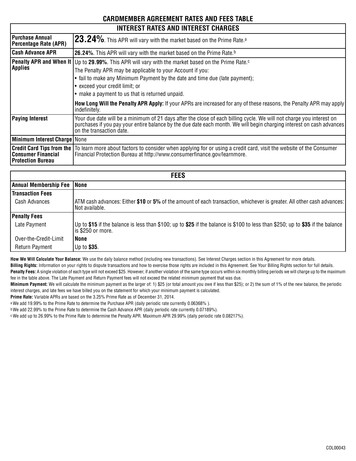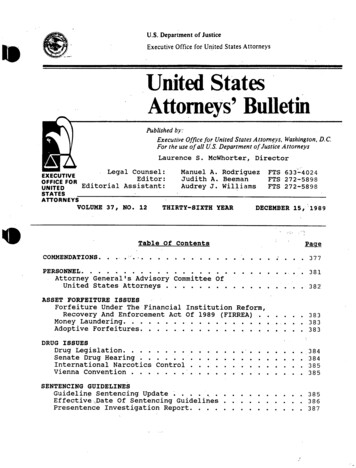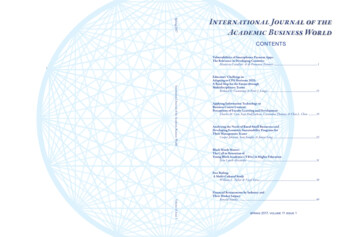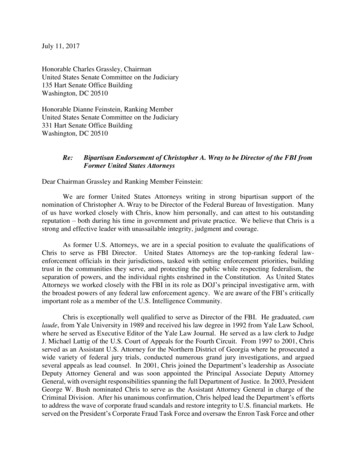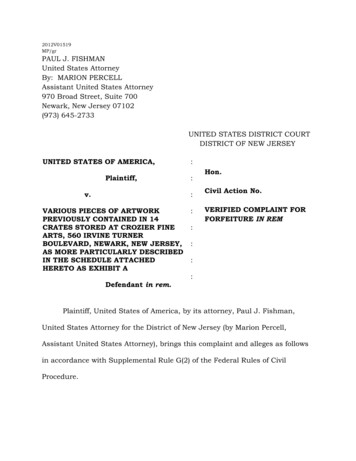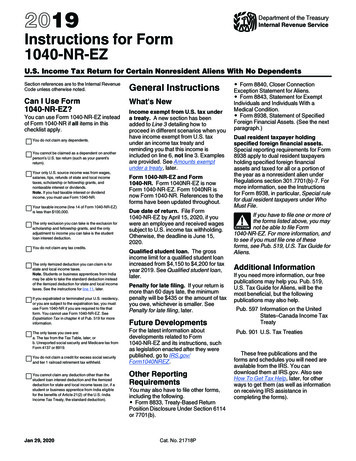
Transcription
UNITED STATES MARINE CORPSMARINE CORPS LOGISTICS BASE814 RADFORD BOULEVARDALBANY, GEORGIA 31704BO 3070.1OTD2000APR 1 s 2moBASE ORDER 3070.1From:To:Commanding OfficerDistribution ListSubj:OPERATIONS SECURITY (OPSEC)Ref:(a) DOD Directive 5205.2, DOD Operations SecurityProgram(b) Joint Pub 3-13.3, Joint Doctrine for OperationsSecurity(c) MCO 3070.2 , The Marine Corps OperationsSecurity Program(d) MARFORCOMO 3070.1, Operations SecurityEncl:(1)(2)(3)(4)(5)1.OPSEC Terms and DefinitionsThe OPSEC ProcessThe OPSEC AssessmentExample Format for Final OPSEC Assessment ReportExamples of Critical InformationSituationa. The current security environment has evolved from onewith identifiable adversarial nation-states to one with lessidentifiable non-state actors and terrorists.Regardless ofstatus, these adversaries have the will and the means to harmU.S. interests at home and abroad.Rapid advances in available,affordable information technology as well as the development ofsophisticated, aggressive collection organizations demand thatwe reconsider what information can be used to compromise ongoing military operations.b. The protection of classified information remains apriority, but the protection of unclassified open sourcematerial must be considered. Methods of collecting criticalpieces of information may include Signals Intelligence (SIGINT) ,Human Intelligence (HUMINT) , and Open Source Intelligence(OSINT), to name a few.Today, 80 percent of collection effortsby adversaries are directed toward open source, unclassifiedinformation.c. In many cases, classified information is neitheressential nor necessary to build an accurate intelligence
BO 3070.1APR 1 5 · ?010picture of what our military forces are doing.Using theassortment of easily obtained, unprotected information, ourobjectives can be determined and a plan can be developed to denyus those objectives. Now, more than ever, each Marine, Sailor,and civilian Marine must be aware of his or her responsibilityto protect unclassified, but potentially useful, informationfrom those who would harm this nation and its military forces.2. Mission. Marine Corps Logistics Base, Albany (MCLBA) willimplement an OPSEC program in order to protect criticalinformation from exploitation by any adversary seeking toobstruct or deny the success of our military operations.3.Executiona.Commander's Intent and Concept of Operations(1) Commander's Intent. To deny potential adversariesaccess to information that could be useful in developing actionsintended to be disruptive to military operations. This will beaccomplished by:(a) Implementing OPSEC programs and policies forMCLBA;(b) Educating Marines, Sailors, civilian Marines,and contractors at all levels in order to raise awareness andincrease control over available information;(c) Requiring both military and civilian directors,managers and supervisors at all levels, to reinforce theimportance of good OPSEC practices with their subordinates. Allpersonnel must adhere to the OPSEC policies designed andimplemented to protect our information from exploitation. Endstate: deny potential adversaries access to critical informationby eliminating or mitigating existing vulnerabilities.(2) Concept of Operations. References (a) through(d), provide specific guidance for OPSEC plans, programdevelopment and establishment. MCLBA will achieve theCommanding Officer's intent by developing and implementingOPSEC programs based on the references listed. MCLBA willalso share their OPSEC concerns with Public Affairs andfamily members to reduce inadvertent disclosures. An annualOPSEC assessment will ensure that the MCLBA program receivesregular command attention and is continually evaluated inorder to remain relevant to command needs. By implementing2
BO 3070.1APR 1 5 2010this guidance, MCLBA will decrease its vulnera ilities whilenegatively impacting adversary abilities to col;lect criticalinformation against our command.b.Tasks(1) Director, Operations and Training Division (OTD2000)(a) Designated lead for MCLBA OPSEC matters.(b) Develop, coordinate, and maintain the CommandOPSEC Program to include writing policy/guidance documents.(c) Lead OPSEC working group to:1. Coordinate OPSEC matters among the specialstaff and divisions.2.Develop and implement the command OPSECProgram.(d) Provide OPSEC subject matter expertise andrecommendations to the commander.(e) Develop and coordinate OPSEC education andtraining.(f) Coordinate command OPSEC surveys.(g) Conduct annual OPSEC review.(h) Develop and maintain an OPSEC lessons learneddatabase.(i) Coordinate and execute command assessments ofMCLBA OPSEC program.(j) Coordinate with other working groups (i.e. AntiTerrorism/Force Protection (ATFP) working group, CriticalInfrastructure Protection (CIP) working group, InformationAssurance (IA) working group, etc.) on OPSEC related matters.(k) Provide assistance to division and special staffas required.(1) Develop OPSEC education and awareness program.3
BO 3070.1APR 1 5 20101. Ensure all personnel are provided OPSECeducation and awareness training annually.2. Develop a program for ensuring newly joinedpersonnel are provided OPSEC education.3. Ensure education and awareness programstresses the importance and role of family in OPSEC.(m) Conduct assessment annually of OPSEC programeffectiveness utilizing the CGRI checklist (to be distributedvia separate correspondence) as well as references (a) through(d) .(2) Command Inspector General(a) In conjunction with the OPSEC Program Manager,create an OPSEC Inspection Checklist utilizing the inspectionchecklist found in reference (c) as a guide.(b) Incorporate OPSEC as a functional area to beinspected during Commanding General's Readiness Inspections(CGRI) .(3) Directors and Special Staff Sections(a) Serve as a member of OPSEC Assessment Team whenrequired.(b) Provide representation to the OPSEC workinggroup as required by the OPSEC Program Manager.c.Coordinating Instructions(1) At a minimum, the following will be included as partof MCLBA OPSEC education programs:(a) Navy OPSEC Course; http://www.niocnorfolk.navy.mil/(b) DoD 2400 Course; http://www.dss.mil/(c) OPSE 2380-2390 Course; http://www.ioss.gov/(d) Army OPSEC Planner's Course;https://www.1stiocmd.army.mil/4
BO 3070.1APR 1 s 70!0(2) MCLBA Program Manager will attend a resident coursewithin 90 days of appointment.(3) OPSEC Program Manager and Coordinators will completean OPSEC Fundamentals Course within 30 days of appointment. Thecourse is available on-line.It is listed as "CBT 1301" and isavailable at the Navy Information Operations Command ns/opsec/main.shtml.Copies of this course can be obtained by emailing the followingorganizational mailbox, opsec@navy.mil or by mailing a requestto: Navy Information Operations Command, ATTN: OPSEC, 2555Amphibious Drive, Norfolk, VA 23521(4) Minimum annual OPSEC training requirements for allpersonnel are:1.An overview of the OPSEC process.2. Defining OPSEC and its relationship to thecommand's security programs.3. Reviewing the command's current criticalinformation list.4. Reviewing the list of the command's personnelfulfilling OPSEC responsibilities for situational awareness.(5) Enclosure (1) is provided as a list of common OPSECdefinitions.(6) Enclosure (2) is provided as an explanation andoutline of the OPSEC Process.(7) Enclosure (3) describes how assessments may beconducted.(8) Enclosure (4) is provided as an example format of aFinal OPSEC Assessment Report.(9) Enclosure (5) is provided as examples of CriticalInformation.(10) MCLBA will submit an annual report, based onfiscal-year time period, detailing their OPSEC program. Guidanceon the format and submission date for this report will bereleased via separate correspondence.5
4.Administration and Logisticsa.Administration(1) Provide MCIEAST contact information of OPSEC ProgramCoordinators to the OPSEC Program Manager.(2) Submit OPSEC Survey Information to the MCLBA OPSECProgram Manager when requested.(3) Capture all costs associated with the OPSEC Programfor future budgetary adjustments.(4) When requested, submit cost data to MCLBA OPSECProgram Manager.b.5.Logistics. N/A.Command and Signala.Command.b.Signal.DISTRIBUTION:Copy to:This Order is applicable to MCLBA.This Order is effective on the date signed.ACG MCIEAST G-36
BO 3070.115 Apr 10OPSEC Terms and Definitions1. This enclosure contains common use terms and definitionsassociated with OPSEC and are provided for a clearerunderstanding of OPSEC as well as assisting with the OPSECProgram creation process.a. Critical Information. These are specific facts aboutfriendly intentions, capabilities, and activities vitally neededby adversaries for them to plan and act effectively so as toguarantee failure or unacceptable consequences for friendlymission accomplishment.b.Excessive OPSEC.Excessive OPSEC can degradeoperational effectiveness by interfering with activities such ascoordination, training, and logistical support. Militaryoperations are inherently risky, and the commander must evaluateeach activity and operation, and then balance required OPSECmeasures against operational needs. Using the OPSEC processwill help commanders assess the risk and apply appropriate OPSECmeasures.c.Essential Elements of Friendly Information(EEFI). EEFIis a term used extensively throughout the Marine Corps and isdefined as "Key questions likely to be asked by adversaryofficials and intelligence systems about specific friendlyintentions, capabilities, and activities, so they can obtainanswers critical to their operational effectiveness."d. OPSEC Assessments. An OPSEC assessment is anexamination of an operation or activity to determine ifadequate protection from adversary intelligence exploitationexists. The OPSEC assessment is used to verify theeffectiveness of OPSEC measures and determine if criticalinformation is being protected. An assessment cannot beconducted until after critical information has been identified.Without understanding critical information which should beprotected, there can be no specific determination that OPSECvulnerabilities exist.e.OPSEC Measures. These are actions taken to reduce theprobability of an enemy from either collecting OPSEC indicatorsor to correctly analyze their meaning.f.OPSEC Process. OPSEC planning is accomplished throughthe OPSEC Process. This has five steps which are usuallyapplied in a sequential order.In dynamic situations, the stepsEnclosure (1)
BO 3070.115 Apr 10may be revisited at any time to adjust to new threats orinformation.Enclosure (2) provides a detailed explanation ofthe OPSEC Process.g.OPSEC Program Managers and Coordinators.ProgramManagers are personnel who have OPSEC duties as their primaryjob. Coordinators are personnel who perform OPSEC functions asan additional duty. Commanders will use their discretion indetermining whether they require OPSEC Program Managers orCoordinators to fulfill their responsibilities.h. OPSEC Working Groups. These are teams of personnel withrepresentatives from the different elements of the command'sorganization designed to assist the command with OPSEC mattersand its program.i. Threat. A threat is any individual or organization thatseeks to do harm by interrupting ongoing military operations oractivities.In order to be classified a threat two conditionsmust be satisfied:(1) An intent to do harm must exist.(2) A capability to do harm must exist.If both conditions cannot be met than a threat does not exist.j. Vulnerability. This is a condition in which friendlyactions provide OPSEC indicators that may be obtained andaccurately evaluated by an adversary in time to provide for abasis for effective adversary decision-making.k.Indicator. These are friendly detectable actions andopen sources of information that adversary intelligence systemscan potentially detect or obtain and then interpret to derivefriendly critical information.2. Many of these terms are further subdivided into categories.Their definitions can be found in references (a) through (d).2
BO 3070.115 Apr 10The OPSEC Process1.Generala.OPSEC is an operations function vice security,intelligence, or counter-intelligence function.b. OPSEC is a process by which we identify criticalinformation, analyzing friendly actions concerning militaryoperations and activities, our vulnerabilities and how thethreat can exploit them to gain information, and the measuresthat we can implement to reduce our vulnerabilities therebyprotecting our critical informationc.OPSEC is a command responsibility.2. OPSEC Process. The OPSEC process is a five step process.Those responsible for OPSEC program creation/implementationshall apply this five-step process that entails:a.Step 1:Identification of Critical Information.The commander and staff tries to identify the questions thatthey believe the enemy will need to know about friendlyintentions, capabilities (and limitations), and activities.These questions are the essential elements of friendlyinformation (EEFI). Critical information is only part of theEEFI, it is the information vitally needed by the enemy. Thisserves to focus the OPSEC Process on protecting the vitalinformation, rather than attempting to protect all information.The EEFI is found in the OPLAN in Tab C to Appendix 3 to Annex C(Operations). This critical information will often times besimilar to what you would want to know about the enemy.b.Step 2: Analysis of Threats. This involves the researchand analysis of intelligence information, counterintelligence,reports, and open source information to identify who the likelyenemy will be. The friendly commander will ask questions, suchas:(1) Who is the enemy or adversary that has intent andcapability to take action against us?(2) What are the enemy's intentions and goals?(3) What is the enemy's strategy for opposing the plannedoperation or activity?(4) What type of tactics and forces will the enemy employ?Enclosure (2)
BO 3070.115 Apr 10(5) What critical information does the enemy already know?(6) What critical information is it too late to protect?(7) What are the enemy's intelligence collectioncapabilities?(8) How does the enemy process and disseminate theircollected data?c.Step 3: Analysis of Vulnerabilities. This actionidentifies an operation's or activity's vulnerabilities. Thisrequires examining the parts of the planned operation andidentifying OPSEC indicators that could reveal criticalinformation. Vulnerabilities exist when the enemy is capable(with the available collection and processing assets) ofobserving an OPSEC indicator, correctly analyzing it, and thentaking appropriate and timely action. The commander will needanswers to questions such as these:(1) What OPSEC indicators of critical information notknown to the enemy will be created by friendly actions thatresult from the planned operation or activity?(2) What OPSEC indicators can the enemy actually collect?(3) What OPSEC indicators can the enemy actually use toour disadvantage?d.Step 4: Assessment of Risk. This step essentially hastwo components. First, planners analyze the identifiedvulnerabilities and then identify possible OPSEC measuresagainst them.Second, specific OPSEC measures are selected forexecution based on the risk assessment done by the commander andstaff.(1) OPSEC Measures can be used to:(a) Prevent the enemy from detecting an OPSECindicator.(b) Provide an alternate analysis of an indicatorfrom the enemy viewpoint (deception) .(c)Directly attack the enemy's collection system(s).2
BO 3070.115 Apr 10(2) Besides physical destruction, OPSEC measures caninclude:(a) Concealment and camouflage.(b) Deception (across all aspects of operations andInformation Operations).(c) Intentional deviations from normal patterns; andconversely, providing a sense of normality.(d) Practicing sound information security, physicalsecurity, and personnel security.(3) More than one OPSEC measure may b
organizational mailbox, opsec@navy.mil or by mailing a request to: Navy Information Operations Command, ATTN: OPSEC, 2555 Amphibious Drive, Norfolk, VA 23521 (4) Minimum annual OPSEC training requirements for all personnel are: 1. An overview of the OPSEC process. 2. Defining OPSEC and its relationship to the




